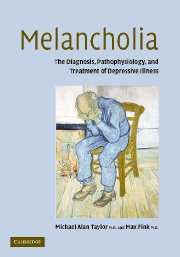Book contents
- Frontmatter
- Contents
- List of patient vignettes
- Preface
- Acknowledgments
- 1 Melancholia: a conceptual history
- 2 Melancholia defined
- 3 Defining melancholia by psychopathology
- 4 Defining melancholia: laboratory tests
- 5 Examination for melancholia
- 6 The differential diagnosis of melancholia
- 7 Suicide in melancholia
- 8 Electroconvulsive therapy for melancholia
- 9 Achieving effective ECT
- 10 The validity of the pharmacotherapy literature in melancholia
- 11 Basic pharmacotherapy for melancholic patients
- 12 Pharmacotherapy for melancholic patients in complicating circumstances
- 13 Proposed treatments for melancholia
- 14 The pathophysiology of melancholia
- 15 Future directions
- References
- Index
3 - Defining melancholia by psychopathology
Published online by Cambridge University Press: 14 August 2009
- Frontmatter
- Contents
- List of patient vignettes
- Preface
- Acknowledgments
- 1 Melancholia: a conceptual history
- 2 Melancholia defined
- 3 Defining melancholia by psychopathology
- 4 Defining melancholia: laboratory tests
- 5 Examination for melancholia
- 6 The differential diagnosis of melancholia
- 7 Suicide in melancholia
- 8 Electroconvulsive therapy for melancholia
- 9 Achieving effective ECT
- 10 The validity of the pharmacotherapy literature in melancholia
- 11 Basic pharmacotherapy for melancholic patients
- 12 Pharmacotherapy for melancholic patients in complicating circumstances
- 13 Proposed treatments for melancholia
- 14 The pathophysiology of melancholia
- 15 Future directions
- References
- Index
Summary
And the mind's canker in its savage mood,
When the impatient thirst of light and air
Parches the heart; and the abhorred grate,
Marring the sunbeams with its hideous shade,
Works through the throbbing eyeball to the brain
With a hot sense of heaviness and pain
The descriptions of melancholia over millennia by medical authorities, writers, and public figures have face validity. The recognition led to the inclusion of “melancholia” in some form in all psychiatric classification systems. This heritage regards melancholia as a disorder in mood accompanied by perturbations in circadian and ultradian rhythms. Psychomotor disturbance is always present, expressed as agitation or inactivity, slowness of movement and speech, catatonia, or stupor. Ruminations of despondency and death dominate the sufferer's waking thoughts. Suicide is all too frequent.
Melancholia is the classic depressive mood disorder. Psychotic depression, manic-depressive depression, puerperal depressions, and abnormal bereavement are part of the melancholia picture. Diverse disease processes, such as endocrinopathies and seizure disorder, induce it. It is recognized worldwide and at all ages, becoming most prominent in older adults. Melancholia is less recognized in young children, but that omission may be a distortion of classification.
Despite its long history, the position of melancholia in psychiatric taxonomy is unclear. Traditionally it was considered a distinct illness. More recently it has been viewed as a stage of illness, not fundamentally different in pathophysiology from other depressive illnesses. Which view is correct?
- Type
- Chapter
- Information
- MelancholiaThe Diagnosis, Pathophysiology and Treatment of Depressive Illness, pp. 45 - 61Publisher: Cambridge University PressPrint publication year: 2006

